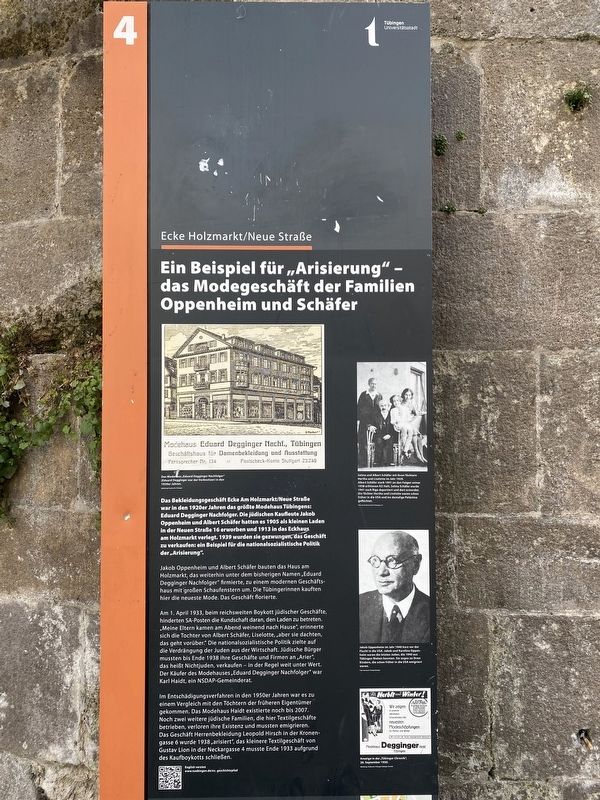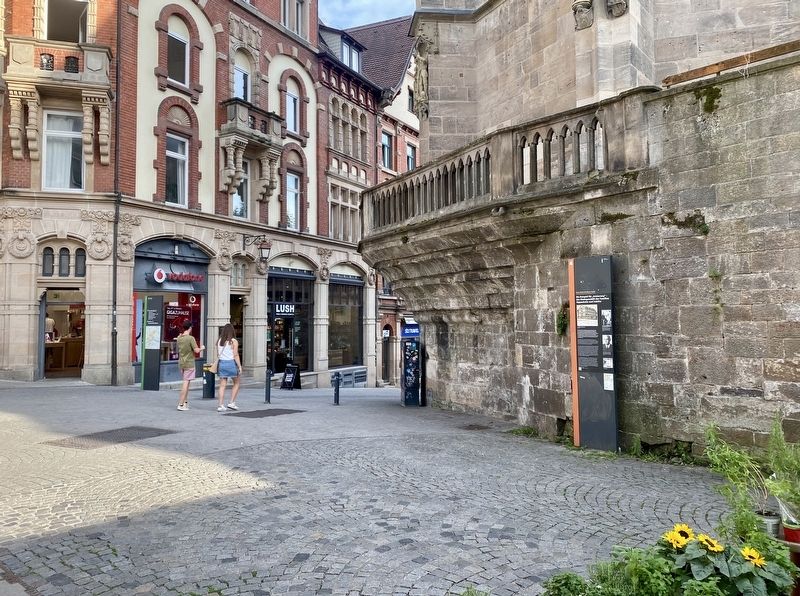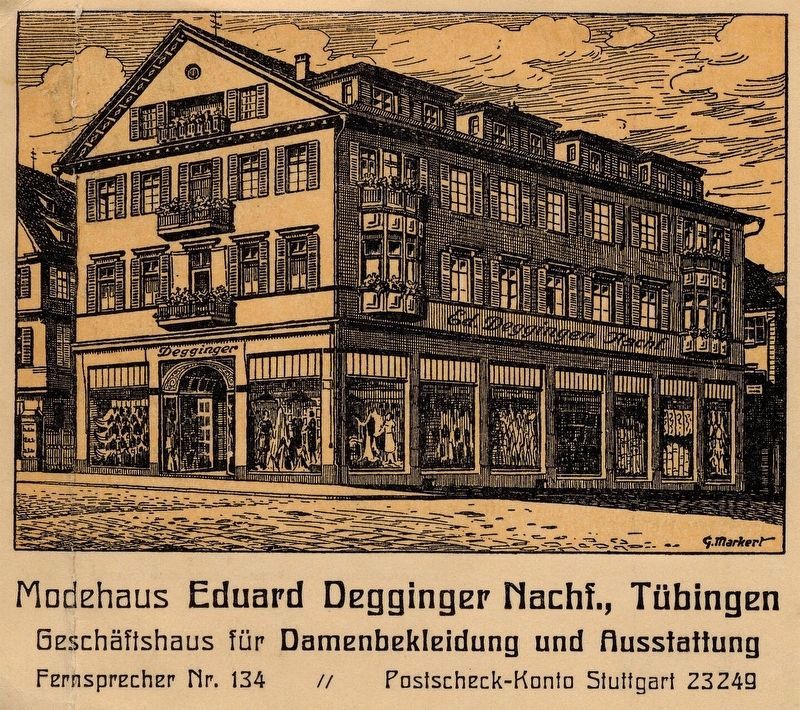Tübingen, Baden-Württemberg, Germany — Central Europe
An Example of "Aryanization": The Oppenheim and Schäfer Families Clothing Store
Ein Beispiel für „Arisierung“ - das Modegeschäft der Familien Oppenheim and Schäfer
— Geschichtspfad zum Nationalsozialismus —
Inscription.
Jakob Oppenheim und Albert Schäfer bauten das Haus am Holzmarkt, das weiterhin unter dem bisherigen Namen „Eduard Degginger Nachfolger“ firmierte, zu einem modernen Geschäftshaus mit großen Schaufenstern um. Die Tübingerinnen kauften hier die neueste Mode. Das Geschäft florierte.
Am 1. April 1933, beim reichsweiten Boykott jüdischer Geschäfte, hinderten SA-Posten die Kundschaft daran, den Laden zu betreten. „Meine Eltern kamen am Abend weinend nach Hause“, erinnerte sich die Tochter von Albert Schäfer, Liselotte, „aber sie dachten, das geht vorüber.“ Die nationalsozialistische Politik zielte auf die Verdrängung der Juden aus der Wirtschaft. Jüdische Bürger mussten bis Ende 1938 ihre Geschäfte und Firmen an „Arier“,das heißt Nichtjuden, verkaufen – in der Regel weit unter Wert. Der Käufer des Modehauses „Eduard Degginger Nachfolger“ war Karl Haidt, ein NSDAP-Gemeinderat.
Im Entschädigungsverfahren in den 1950er Jahren war es zu einem Vergleich mit den Töchtern der früheren Eigentümer gekommen. Das Modehaus Haidt existierte noch bis 2007. Noch zwei weitere jüdische Familien, die hier Textilgeschäfte betrieben, verloren ihre Existenz und mussten emigrieren. Das Geschäft Herrenbekleidung Leopold Hirsch in der Kronengasse 6 wurde 1938 „arisiert“, das kleinere Textilgeschäft von Gustav Lion in der Neckargasse 4 musste Ende 1933 aufgrund des Kaufboykotts schließen.
Situated at the corner of Holzmarkt and Neue Straße, Tübingen's biggest clothing store in the 1920s was Eduard Degginger Nachfolger. Jewish merchants Jakob Oppenheim and Albert Schäfer had bought the business in 1905 when it was still a small store in Neue Straße 16. They moved it to the corner house on Holzmarkt in 1913. In 1939, they were forced to sell their business. This is an example for the National Socialist policy of "Arisierung" ("Aryanization"), the expropriation of Jewish property.
Keeping the name Eduard Degginger Nachfolger, (Eduard Degginger was the previous owner, "Nachfolger" means "successor"),
Jakob Oppenheim and Albert Schäfer remodeled the house on Holzmarkt into a modern business building with large display windows. Female Tübingers bought the latest fashion here. The business flourished.
On April 1, 1933, during the boycott of Jewish businesses throughout the Reich, brown-shirt stormtroopers from the Sturmabteilung ("Storm Detachment," SA) prevented customers from entering the store. Liselotte, daughter of Albert Schäfer, remembered: "My parents returned home that night crying, but they thought this episode would pass by." National Socialist policies aimed at driving Jews out of the economy. By late 1938, Jewish citizens had to sell their businesses and companies to "Arier" ("Aryans"), that is, non-Jews. Usually the sales price was very much below the real value of the respective enterprise. Karl Haidt, Tübingen Gemeinderat (town councilman) for the Nationalsozialistische Deutsche Arbeiterpartei (National Socialist German Worker's Party, NSDAP), bought the Eduard Degginger Nachfolger clothing store.
The restitution case in the 1950s resulted in a compromise agreement with the daughters of the previous owners. The Haidt fashion store was in existence until 2007. There were two additional Jewish families in Tübingen who owned textile stores, lost their livelihood, and had to emigrate. The men's clothing store Herrenkleidung Leopold Hirsch in Kronengasse
6 was "aryanized" in 1938; the smaller textile business of Gustav Lion in Neckargasse 4 had to close in late 1933 due to the boycott.
Erected 2016 by Geschichtswerkstatt Tübingen. (Marker Number 4.)
Topics and series. This historical marker is listed in this topic list: Industry & Commerce. In addition, it is included in the The Holocaust series list. A significant historical date for this entry is April 1, 1933.
Location. 48° 31.219′ N, 9° 3.383′ E. Marker is in Tübingen, Baden-Württemberg. Marker is at the intersection of Holzmarkt and Neckargasse, on the right when traveling east on Holzmarkt. Touch for map. Marker is in this post office area: Tübingen BW 72070, Germany. Touch for directions.
Other nearby markers. At least 8 other markers are within walking distance of this marker. University of Tübingen Holocaust Memorial (here, next to this marker); Tübingen Roma and Sinti Memorial (here, next to this marker); Buchhandlung Gastl / Gastl Bookstore (a few steps from this marker); Josef Eberle (Sebastian Blau) (within shouting distance of this marker); Hermann Hesse (within shouting distance of this marker); Bebenhäuser Pfleghof (within shouting distance of this marker); Nikodemus Frischlin (within shouting distance of this marker); Gottlob Himmel (within shouting distance of this marker). Touch for a list and map of all markers in Tübingen.
Credits. This page was last revised on September 28, 2022. It was originally submitted on September 28, 2022, by Andrew Ruppenstein of Lamorinda, California. This page has been viewed 156 times since then and 48 times this year. Photos: 1, 2, 3. submitted on September 28, 2022, by Andrew Ruppenstein of Lamorinda, California.


